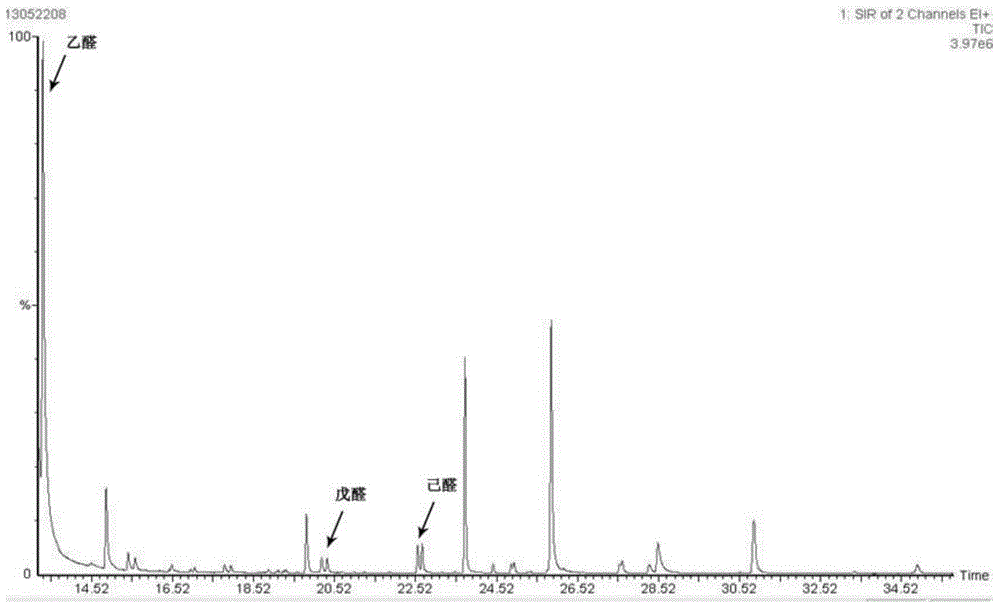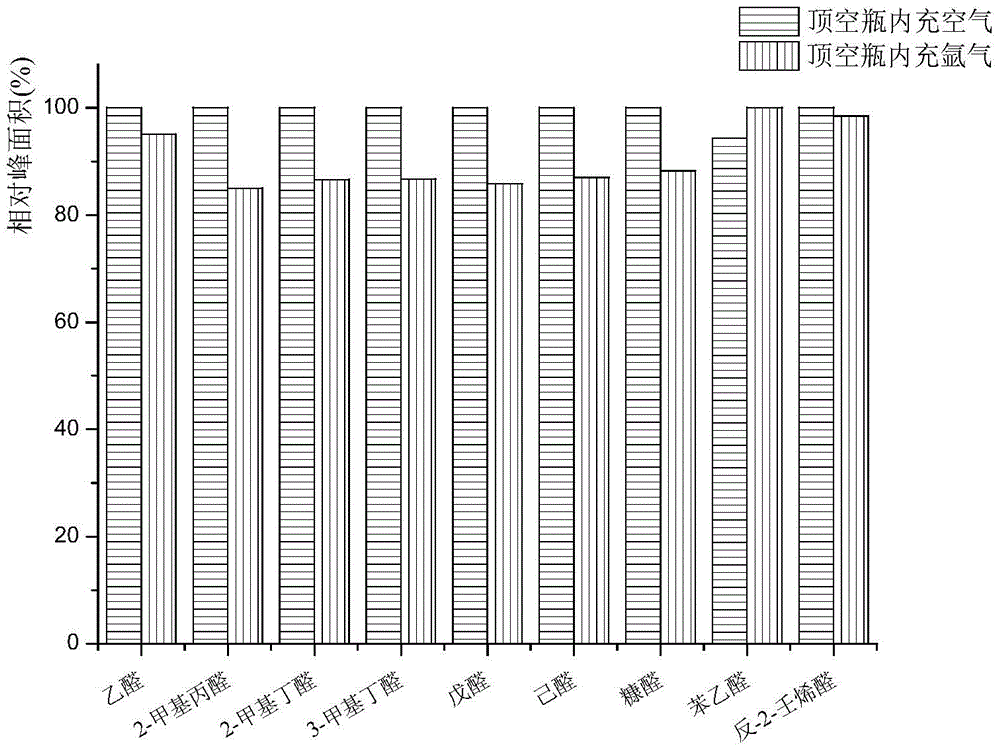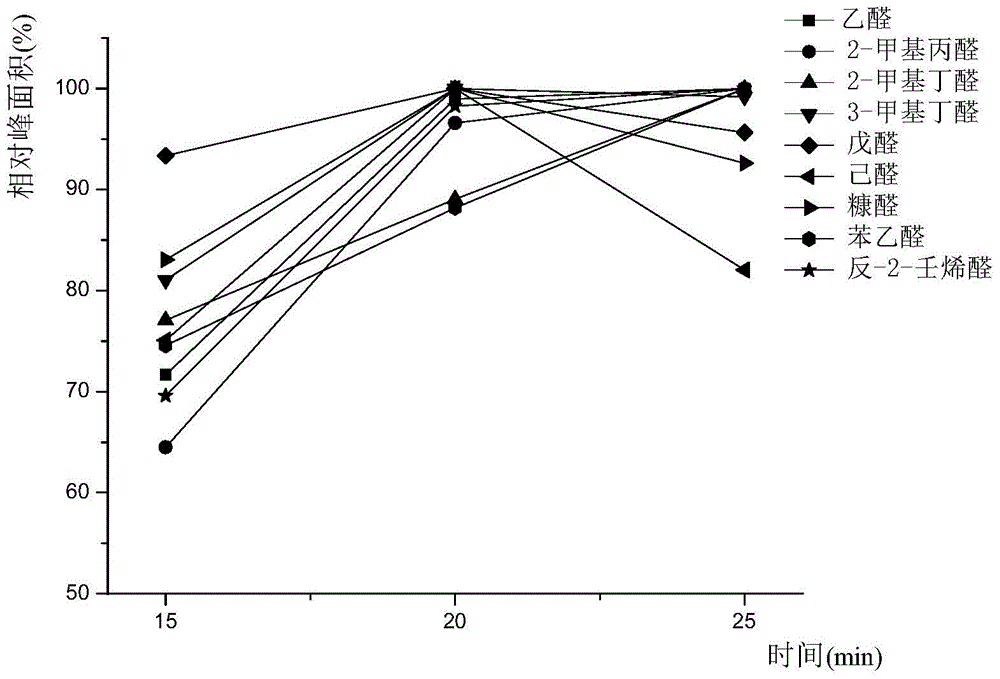Method for detecting aldehydes in rice
A technology for rice and aldehydes, which is applied in the field of analysis and detection of aldehydes, can solve problems such as inaccurate detection results, and achieve the effects of ensuring accuracy, improving authenticity and reliability, and improving the recovery rate of standard addition
- Summary
- Abstract
- Description
- Claims
- Application Information
AI Technical Summary
Problems solved by technology
Method used
Image
Examples
Embodiment 1
[0041] (1) The rice sample was crushed three times through a cyclone mill and passed through a 120-mesh sieve.
[0042] (2) Add the sample to be tested into the headspace bottle, fill the headspace bottle with inert gas argon, cover the bottle cap and place it on the sample tray.
[0043] (3) Headspace derivatized solid-phase microextraction was completed with the help of a multifunctional sampler. Insert the 65 μm PDMS / DVB extraction head into the headspace bottle filled with the derivatization solution o-pentafluorobenzyl hydroxylamine for 20 minutes for derivatization. Then insert the extraction head into the headspace vial containing the rice sample and extract at 40°C for 80 minutes.
[0044] (4) Insert the extraction head into the GC-MS inlet, desorb for 2 minutes and enter the GC-MS detection.
[0045] (5) The chromatographic conditions during detection are: chromatographic column HP-5ms (60m×0.32mm×0.25μm). The carrier gas is helium at a flow rate of 1.5 mL / min. Th...
Embodiment 2
[0049] (1) Effect of water addition on sample detection
[0050] Whether there is water in the detection process has a great influence on the detection of aldehydes. On the one hand, aldehydes may be contained in the water to interfere with the detection of samples. On the other hand, the enzyme activity in aqueous solution is relatively large, such as lipoxygenase, and lipoxygenase will oxidize fatty acids. This produces aldehydes. When detecting aldehydes in water, it is found that the content of acetaldehyde, valeraldehyde and hexanal is high, and acetaldehyde has great interference on the detection of samples (such as figure 1 shown).
[0051] (2) Crushing method
[0052] The number of rice crushing is not only related to the size of the particles, but also related to the uniformity of the particles. The influence of crushing times on the precision of the method was investigated by calculating the relative standard deviation (RSD) of 5 parallel samples, and the results ...
Embodiment 3
[0064] (1) Preparation of standard curve and method evaluation
[0065] Add standard substances of different gradients dissolved in ethanol to the rice sample in the headspace bottle. After using the instrument for detection, take the sample without adding the standard as the blank, and measure the peak area of each aldehyde after the addition of the standard. After standardization, the peak area increase value of each component is y, and the scalaring amount is x, and a standard curve is drawn, and the standard curve is forced to pass through the origin. The results showed that the optimal standard addition volume was 5 μL, and the standard curves of each aldehyde had good linearity within their respective linear ranges (2-1000 μg / kg), with R2 greater than 0.99, which could meet the requirements of accurate quantitative analysis. The results are shown in Table 3. The samples in the headspace vial were added with and without 5 μL of ethanol, and the results showed that the a...
PUM
 Login to View More
Login to View More Abstract
Description
Claims
Application Information
 Login to View More
Login to View More - R&D
- Intellectual Property
- Life Sciences
- Materials
- Tech Scout
- Unparalleled Data Quality
- Higher Quality Content
- 60% Fewer Hallucinations
Browse by: Latest US Patents, China's latest patents, Technical Efficacy Thesaurus, Application Domain, Technology Topic, Popular Technical Reports.
© 2025 PatSnap. All rights reserved.Legal|Privacy policy|Modern Slavery Act Transparency Statement|Sitemap|About US| Contact US: help@patsnap.com



